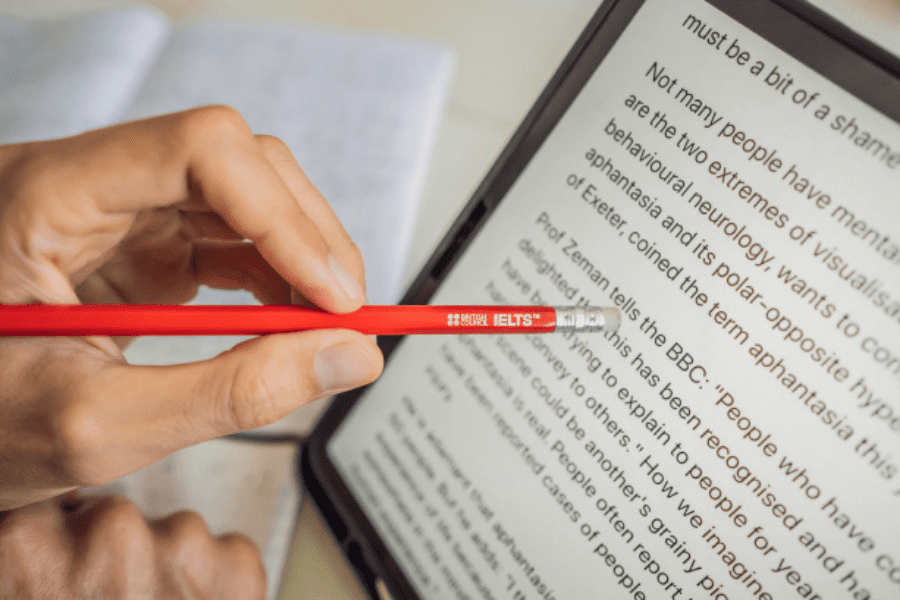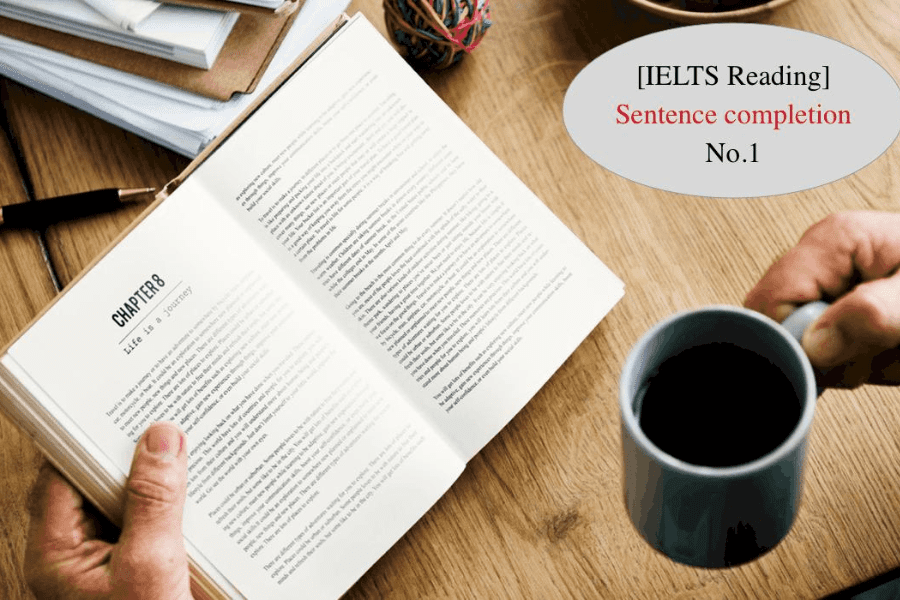Matching Sentence Endings tuy hóc búa nhưng không thể làm khó bạn nếu nắm chắc những bí kíp được TDP IELTS chia sẻ với bạn chiến thuật làm bài Matching Sentence Endings IELTS Reading.

Tìm hiểu thêm: Lộ trình học IELTS từ 0 đến 6.5+ cho người mới bắt đầu chi tiết nhất
Nội dung
ToggleYêu cầu dạng bài IELTS Reading Matching Sentence Endings
Dạng bài Matching Endings yêu cầu bạn nối mỗi vế đầu của câu chưa hoàn chỉnh (incomplete sentence) với một vế sau phù hợp (ending) dựa trên nội dung bài đọc. Để làm tốt dạng bài này, bạn cần hiểu được cách liên kết ý trong câu và cấu trúc ngữ pháp của câu.
Chiến thuật làm bài – IELTS Reading Matching Sentence Endings Tips
Sau khi đọc câu hỏi Matching Sentence Ending Questions việc đầu tiên bạn cần làm là hít thở thật sâu và bắt tay vào áp dụng công thức sau:
Bước 1: Đọc kỹ các vế đầu và xác định từ khóa (không đọc các vế sau).
Bước 2: Xác định vị trí các từ khóa trong bài đọc (scanning)
Bước 3: Đọc kỹ nội dung xung quanh từ khóa của câu đầu tiên. Nắm vững ý chính của đoạn văn vừa đọc.
Bước 4: Đọc qua các endings (vế sau) và chọn đáp án phù hợp với nội dung vừa đọc.
Bước 5: Lặp lại bước 2, 3, 4. Chú ý kiểm tra kỹ ngữ nghĩa, ngữ pháp cả câu.
- Tips:
-
- Câu trả lời xuất hiện theo thứ tự đoạn văn.
- Chỉ đọc đề (incomplete sentence) rồi đọc ngay vào bài văn. Đọc hết các endings sẽ gây nhiễu thông tin khi đọc bài và chọn đáp án.
- Cố gắng paraphrase câu hỏi trước khi đọc bài.
- Bạn có thể dễ dàng loại bỏ các endings không phù hợp khi:
-
-
- Không chứa các thông tin liên quan đến đoạn vừa đọc
- Không hòa hợp về mặt ngữ pháp
- Không có nghĩa khi ghép với các vế đầu.
-
Bài tập mẫu IELTS Academic Reading Matching Sentence Endings Practice
How geckos cope with wet feet
A
Geckos are remarkable little lizards, clinging to almost any dry surface, and Alyssa Stark, from the University of Akron, US, explains that they appear to be equally happy scampering through tropical rainforest canopies as they are in urban settings. ‘A lot of gecko studies look at the very small adhesive structures on their toes to understand how the system works at the most basic level’; says Stark. She adds that the animals grip surfaces with microscopic hairs on the soles of their feet, which make close enough contact to be attracted to the surface by the minute forces between atoms.
B
However, she and her colleagues Timothy Sullivan and Peter Niewiarowski were curious about how the lizards cope on surfaces in their natural habitat. Explaining that previous studies had focused on the reptiles clinging to artificial dry surfaces, Stark says ‘We know they are in tropical environments that probably have a lot of rain and geckos don’t suddenly fall out of the trees when it’s wet.’Yet, the animals do seem to have trouble getting a grip on smooth, wet, artificial surfaces, sliding down wet vertical glass after several steps. The team decided to find out how geckos with wet feet cope on both wet and dry surfaces.
C
First, they had to find out how well their geckos clung onto glass with dry feet. Fitting a tiny harness around the lizard’s pelvis and gently lowering the animal onto a plate of smooth glass, Stark and Sullivan allowed the animal to become well attached before connecting the harness to a tiny motor and gently pulling the lizard until it came unstuck. The geckos hung on tenaciously, and only came unstuck at forces of around 20N – about 20 times their own body weight. “In my view, the gecko attachment system is over – designed’, says Stark.
D
Next, the trio sprayed the glass plate with a midst of water and re-tested the lizards, but this time the animals had problems holding tight. The droplets were interfering with the lizards’ attachment mechanism, but it wasn’t clear how. And when the team immersed the geckos in a bath of room – temperature water with a smooth glass bottom, the animals were completely unable to anchor themselves to the smooth surface. ‘The toes are super – hydrophobic’, (i.e. water repellant) explains Stark, who could see a silvery bubble of air around their toes. But, they were unable to displace the water around their feet to make the tight contact that usually keeps geckos in place.
E
Then the team tested the lizard’s adhesive forces on the dry surface when their feet had been soaking for 90 minutes, and found that the lizards could barely hold on, detaching when they were pulled with a force roughly equalling their own weight. ‘That might be the sliding behaviour that we see when the geckos climb vertically up misted glass’, says Stark. So, geckos climbing on wet surfaces with damp feet are constantly on the verge of slipping and Stark adds that when the soggy lizards were faced with the misted and immersed horizontal surfaces, they slipped as soon as the rig started pulling. Therefore geckos can walk on wet surfaces, as long as their feet are reasonably dry. However, as soon as their feet get wet, they are barely able to hang on, and the team is keen to understand how long it takes geckos to recover from a drenching.
Read the relevant part of the passage carefully, then choose the best sentence ending (A-F).
1 Other researchers have aimed to discover how
2 The work of Stark and her team is different because they wanted to find out how
3 Stark’s experiments revealed that
4 The researchers would still like to know when
| A geckos struggle to grip onto dry glass as well as wet glass.
B the gripping mechanism of geckos actually works. C geckos have a weaker gripping mechanism than previously thought. D geckos are able to grip in rainforest settings. E geckos are able to recover their gripping abilities after getting wet. F geckos can grip more easily if their feet are not damp. |
Hướng dẫn chi tiết cách làm Match Sentence Endings IELTS
How geckos cope with wet feet IELTS Reading Answer
Dưới đây là cách xác định how geckos cope with wet feet đáp án bao gồm how geckos cope with wet feet key để giúp bạn tìm ra câu trả lời dễ dàng hơn.
| Bước | Cách làm | Giải thích |
| Bước 1: Đọc kỹ các vế đầu và xác định từ khóa (không đọc các vế sau). | 1 Other researchers have aimed to discover how
2 The work of Stark and her team is different because they wanted to find out how 3 Stark’s experiments revealed that 4 The researchers would still like to know when |
Các từ khóa đã được gạch chân |
| Bước 2: Xác định vị trí các từ khóa trong bài đọc (scanning) | Dùng nội dung câu hỏi đầu tiên để xác định vị trí các câu trả lời trong bài đọc:
1 Other researchers have aimed to discover how ‘A lot of gecko studies look at the very small adhesive structures on their toes to understand how the system works at the most basic level’; says Stark |
Từ khóa giúp định vị bài đọc:
– Other researchers = A lot of gecko studies – look at = aim to – discover how = understand how |
| Bước 3: Đọc kỹ nội dung xung quanh từ khóa của câu đầu tiên. Nắm vững ý chính của đoạn văn vừa đọc. | Đọc kỹ và nắm nội dung toàn đoạn “to understand how the system works” | |
| Bước 4: Đọc qua các endings (vế sau) và chọn đáp án phù hợp với nội dung vừa đọc. | Đáp án B có nhiều thông tin khớp với đoạn vừa đọc nhất
B the gripping mechanism of geckos actually works.
|
Từ khóa đáp án:
– mechanism = system – actually works = works
→ Đáp án đúng: 1 B |
| Bước 5: Lặp lại bước 2, 3, 4. Chú ý kiểm tra kỹ ngữ nghĩa, ngữ pháp cả câu. | 2 The work of Stark and her team is different because they wanted to find out how
“…she and her colleagues Timothy Sullivan and Peter Niewiarowski were curious about how the lizards cope on surfaces in their natural habitat. Explaining that previous studies had focused on the reptiles clinging to artificial dry surfaces” Thông tin đi kèm đoạn vừa xác định được là “Stark says ‘We know they are in tropical environments that probably have a lot of rain and geckos don’t suddenly fall out of the trees when it’s wet.” → D geckos are able to grip in rainforest settings. |
Từ khóa định vị:
– Stark and her team = she and her colleagues – different = in their natural habitat >< artificial dry surfaces – find out = curious about
Từ khóa đáp án: – cope on surfaces = able to grip – in their natural habitat/tropical/rain/trees = in rainforest settings. → Đáp án đúng: 2 D |
| 3 Stark’s experiments revealed that
Các đoạn tiếp theo sau câu 2 đều mô tả các thí nghiệm, và đoạn cuối nhắc đến kết quả” “Then the team tested the lizard’s adhesive forces on the dry surface when their feet had been soaking for 90 minutes, and found that… Therefore geckos can walk on wet surfaces, as long as their feet are reasonably dry.” → F geckos can grip more easily if their feet are not damp. |
Từ khóa định vị:
– revealed that = found that
Từ khóa đáp án – walk on wet surfaces = grip more easily – as long as = if – reasonably dry = not damp
→ Đáp án đúng: 3 F |
|
| 4 The researchers would still like to know when
Vì đáp án theo thứ tự câu hỏi nên phần dẫn chứng còn lại sẽ nằm sau dẫn chứng của câu 3: “However, as soon as their feet get wet, they are barely able to hang on, and the team is keen to understand how long it takes geckos to recover from a drenching.” → E geckos are able to recover their gripping abilities after getting wet. |
Từ khóa định vị:
– the researchers = the team – like to know = keen to understand – when = how long
Từ khóa đáp án: – recover = recover – getting wet = drenching |
Với cách giải thích trên, hy vọng bạn đã hiểu rõ bài IELTS Reading how geckos cope with wet feet nhé.
Matching Sentence Endings IELTS Reading Practice – Luyện tập
Practice test 61
A Bar at the folies (Un bar aux folies)
A
One of the most critically renowned paintings of the 19th-century modernist movement is the French painter Edouard Manet’s masterwork. A Bar at the Folies. Originally belonging to the composer Emmanuel Chabrier, it is now in the possession of The Courtauld Gallery in London, where it has also become a favourite with the crowds.
B
The painting is set late at night in a nineteenth-century Parisian nightclub. A barmaid stands alone behind her bar, fitted out in a black bodice that has a frilly white ‘leckline. and with a spray of flowers sitting across her decolletage. She rests her hands on the bar and gazes out forlornly at a point just below the viewer, not quite “laking eye contact. Also on the bar are some bottles of liquor and a bowl of oranges, much of the activity in the room takes place in the reflection of a mirror behind the barmaid. Through this mirror we see an auditorium, oustling with blurred figures and faces: men in top hats, a woman examining the scene below her through omoculars, another in long gloves, even the feet of a trapeze artist demonstrating acrobatic feats above his adoring crowd. In the foreground of the reflection, a man with a thick moustache is talking with the barmaid.
C
Although the Folies (-Bergere) was an actual establishment in late nineteenth-century Paris, and the subject of the painting was a real barmaid who worked there, Manet did not attempt to recapture every detail of the bar in his rendition. The painting was largely completed in a private studio belonging to the painter, where the barmaid posed with a number of bottles, and this was then integrated with quick sketches the artist made at the Folies itself.
D
Even more confounding than Manet’s relaxed attention to detail, however, is the relationship in the painting between the activity in the mirrored reflection and that which we see in the unreflected foreground. In a similar vein to Diego Velazquez’ much earlier work Las Meninas, Manet uses the mirror to toy with our ideas about which details are true to life and which are not. In the foreground, for example, the barmaid is positioned upright, her face betraying an expression of lonely detachment, yet in the mirrored reflection she appears to be leaning forward and to the side, apparently engaging in conversation with her moustachioed customer. As a result of this, the customer’s stance is also altered. In the mirror, he should be blocked from view as a result of where the barmaid is standing, yet Manet has re-positioned him to the side. The overall impact on the viewer is one of a dreamlike dis-juncture between reality and illusion.
E
Why would Manet engage in such deceit? Perhaps for that very reason: to depict two different states of mind or emotion. Manet seems to be conveying his understanding of the modern workplace, a place – from his perspective – of alienation, where workers felt torn from their ‘true’ selves and forced to assume an artificial working identity. What we see in the mirrored reflection is the barmaid’s working self, busy serving a customer. The front-on view, however, bears witness to how the barmaid truly feels at work: hopeless, adrift, and alone.
F
Ever since its debut at the Paris Salon of 1882, art historians have produced reams of books and journal articles disputing the positioning of the barmaid and patron in A Bar at the Some have even conducted staged representations of the painting in order to ascertain whether Manet’s seemingly distorted point of view might have been possible after all. Yet while academics are understandably drawn to the compositional enigma of the painting, the layperson is always likely to see the much simpler, more human story beneath. No doubt this is the way Manet would have wanted it.
Complete each sentence with the correct ending, A-F, below.
Write the correct letter, A-F.
- Manet misrepresents the images in the mirror because he
- Manet felt modern workers were alienated because they
- Academics have re-constructed the painting in real life because they.
| List of endings
A wanted to find out if the painting’s perspective was realistic B felt they had to work very hard at boring and difficult jobs C wanted to understand the lives of ordinary people at the time D felt like they had to become different people E wanted to manipulate our sense of reality F wanted to focus on the detail in the painting |
Practice test 62
Makete Integrated Rural Transport Project
(Excerpt)
Section C
Having determined the main transport needs, possible solutions were identified which might reduce the time and burden. During Phase II, from January to February 1991, a number of approaches were implemented in an effort to improve mobility and access to transport.
An improvement of the road network was considered necessary to ensure the import and export of goods to the district. These improvements were carried out using methods that were heavily dependent on labour.
In addition to the improvement of roads, these methods provided training in the operation of a mechanical workshop and bus and truck services. However, the difference from the conventional approach was that this time consideration was given to local transport needs outside the road network.
Most goods were transported along the paths that provide short-cuts up and down the hillsides, but the paths were a real safety risk and made the journey on foot even more arduous. It made sense to improve the paths by building steps, handrails and footbridges.
It was uncommon to find means of transport that were more efficient than walking but less technologically advanced than motor vehicles. The use of bicycles was constrained by their high cost and the lack of available spare parts. Oxen were not used at all but donkeys were used by a few households in the northern part of the district. MIRTP focused on what would be most appropriate for the inhabitants of Makete in terms of what was available, how much they could afford and what they were willing to accept. After careful consideration, the project chose the promotion of donkeys – a donkey costs less than a bicycle – and the introduction of a locally manufacturable wheelbarrow.
Section D
At the end of Phase II, it was clear that the selected approaches to Makete’s transport problems had had different degrees of success. Phase III, from March 1991 to March 1993, focused on the refinement and institutionalisation of these activities. The road improvements and accompanying maintenance system had helped make the district centre accessible throughout the year. Essential goods from outside the district had become more readily available at the market, and prices did not fluctuate as much as they had done before.
Paths and secondary roads were improved only at the request of communities who were willing to participate in construction and maintenance. However, the improved paths impressed the inhabitants, and requests for assistance greatly increased soon after only a few improvements had been completed.
The efforts to improve the efficiency of the existing transport services were not very successful because most of the motorised vehicles in the district broke down and there were no resources to repair them. Even the introduction of low-cost means of transport was difficult because of the general poverty of the district. The locally manufactured wheelbarrows were still too expensive for all but a few of the households. Modifications to the original design by local carpenters cut production time and costs. Other local carpenters have been trained in the new design so that they can respond to requests. Nevertheless, a locally produced wooden wheelbarrow which costs around 5000 Tanzanian shillings (less than US$20) in Makete, and is about one quarter the cost of a metal wheelbarrow, is still too expensive for most people.
Donkeys, which were imported to the district, have become more common and contribute, in particular, to the transportation of crops and goods to market. Those who have bought donkeys are mainly from richer households but with an increased supply through local breeding, donkeys should become more affordable. Meanwhile, local initiatives are promoting the renting out of the existing donkeys. It should be noted, however that a donkey, which at 20,000 Tanzanian shillings costs less than a bicycle, is still an investment equal to an average household’s income over half a year This clearly illustrates the need for supplementary measures if one wants to assist the rural poor.
Complete each sentence with the correct ending, A-J below.
Write the correct letter, A-J.
- Construction of footbridges, steps and handrails
- Frequent breakdown of buses and trucks in Makete
- The improvement of secondary roads and paths
- The isolation of Makete for part of the year
| List of endings
A provided the people of Makete with experience in running bus and truck services. B was especially successful in the northern part of the district. C differed from earlier phases in that the community became less actively involved. D improved paths used for transport up and down hillsides. E was no longer a problem once the roads had been improved. F cost less than locally made wheelbarrows. G was done only at the request of local people who were willing to lend a hand. H was at first considered by MIRTP to be affordable for the people of the district. I hindered attempts to make the existing transport services more efficient. J was thought to be the most important objective of Phase III. |
Practice test 63
Telepathy
(Excerpt)
Some researchers say the results constitute compelling evidence that telepathy is genuine. Other parapsychologists believe the field is on the brink of collapse, having tried to produce definitive scientific proof and failed. Sceptics and advocates alike do concur on one issue, however: that the most impressive evidence so far has come from the so-called ‘ganzfeld’ experiments, a German term that means ‘whole field’. Reports of telepathic experiences had by people during meditation led parapsychologists to suspect that telepathy might involve ‘signals’ passing between people that were so faint that they were usually swamped by normal brain activity. In this case, such signals might be more easily detected by those experiencing meditation-like tranquility in a relaxing ‘whole field’ of light, sound and warmth.
The ganzfeld experiment tries to recreate these conditions with participants sitting in soft reclining chairs in a sealed room, listening to relaxing sounds while their eyes are covered with special filters letting in only soft pink light. In early ganzfeld experiments, the telepathy test involved identification of a picture chosen from a random selection of four taken from a large image bank. The idea was that a person acting as a ‘sender’ would attempt to beam the image over to the ‘receiver’ relaxing in the sealed room. Once the session was over, this person was asked to identify which of the four images had been used. Random guessing would give a hit-rate of 25 per cent; if telepathy is real, however, the hit-rate would be higher. In 1982, the results from the first ganzfeld studies were analysed by one of its pioneers, the American parapsychologist Charles Honorton. They pointed to typical hit-rates of better than 30 per cent – a small effect, but one which statistical tests suggested could not be put down to chance.
[…]
What they are certainly not finding, however, is any change in attitude of mainstream scientists: most still totally reject the very idea of telepathy. The problem stems at least in part from the lack of any plausible mechanism for telepathy.
Various theories have been put forward, many focusing on esoteric ideas from theoretical physics. They include ‘quantum entanglement’, in which events affecting one group of atoms instantly affect another group, no matter how far apart they may be. While physicists have demonstrated entanglement with specially prepared atoms, no-one knows if it also exists between atoms making up human minds. Answering such questions would transform parapsychology. This has prompted some researchers to argue that the future lies not in collecting more evidence for telepathy, but in probing possible mechanisms. Some work has begun already, with researchers trying to identify people who are particularly successful in autoganzfeld trials. Early results show that creative and artistic people do much better than average: in one study at the University of Edinburgh, musicians achieved a hit-rate of 56 per cent. Perhaps more tests like these will eventually give the researchers the evidence they are seeking and strengthen the case for the existence of telepathy.
Complete each sentence with the correct ending, A —G, below. Write the correct letter, A—G.
- Researchers with differing attitudes towards telepathy agree on
- Reports of experiences during meditation indicated
- Attitudes to parapsychology would alter drastically with
- Recent autoganzfeld trials suggest that success rates will improve with
| List of endings
A the discovery of a mechanism for telepathy. B the need to create a suitable environment for telepathy. C their claims of a high success rate. D a solution to the problem posed by random guessing. E the significance of the ganzfeld experiments. F a more careful selection of subjects. G a need to keep altering conditions. |
Xem thêm: Chiến Thuật Làm Bài Matching Features IELTS Reading
Lời kết
Hy vọng những bài tập Matching Sentence Endings nêu trên đã giúp ích được phần nào trong quá trình ôn luyện IELTS. Theo dõi Fanpage TDP IELTS – IELTS cấp tốc để cập nhật thêm thông tin mới nhất!













